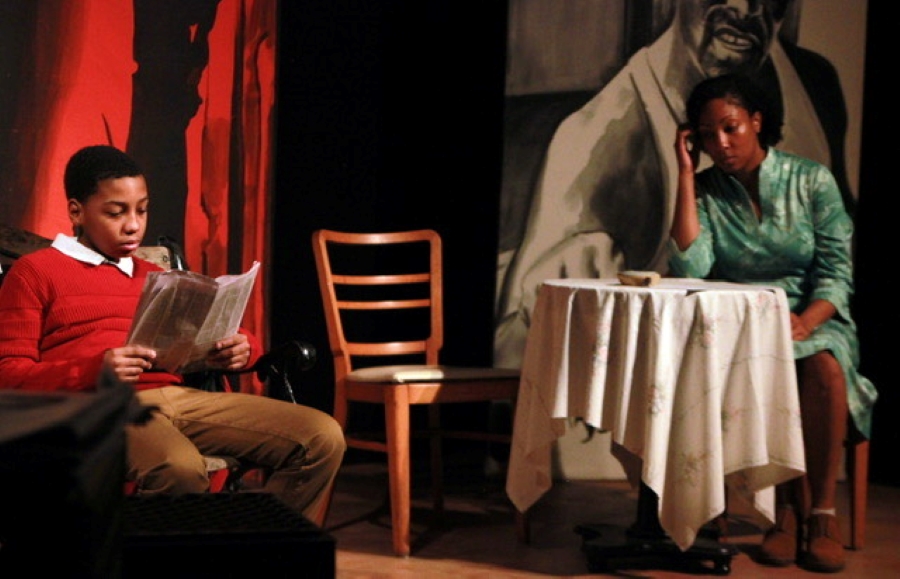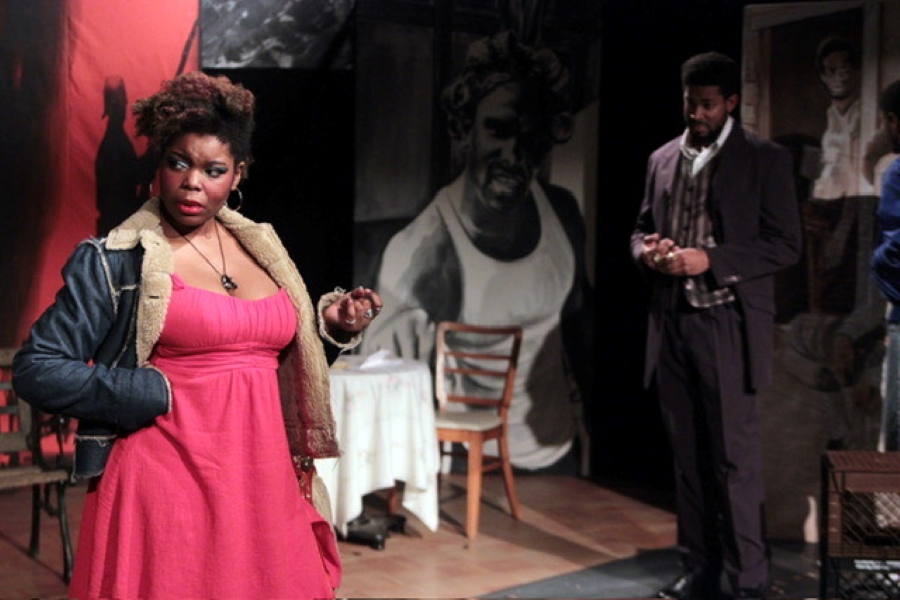“I wrote this director’s note 13 years ago,” reads the prologue to Carla Stillwell’s note in the playbill for Tad in 5th City, now at Ma’at Production Association of Afrikan Centered Theatre’s (MPAACT) through March 3. “Well before Covid or MAGA or Floyd and Black Lives Matter, and yet I don’t feel a need to change a word.”
Born of the poetry and writings of Orron Kenyatta I and adapted by Stillwell, Tad in 5th City was first produced during MPAACT’s 2010 season. But Stillwell, who is also directing this new production, said that her director’s note demonstrates her continuing view that telling historically accurate Chicago stories matters, and that this kind of work helps us make sense of the Chicago of today.
“History records the facts, along with the specific cause and effects of a particular action,” added Lenora Inez Brown, the original dramaturg for Tad in 5th City. “Art takes those facts and provides the emotional and soulful side to those facts. Art gives voice to the often voiceless or unheard. We look to artists to delve beyond recorded history to chronicle how society’s events impact individual lives. When we revisit the past we have an opportunity to better understand our present (as an individual or a society) and to see how we’ve arrived to this specific moment. And of course, if we do not know the history we are doomed to repeat it.”
Tad is set in 5th City, a West Side Chicago neighborhood developed with the idea of redefining how communities are organized, in 1978. Through the eyes of 10-year-old protagonist Tad Brown, the show dramatizes some of the ways the city changed after the assassination of Dr. Martin Luther King Jr. 10 years before. Stillwell recalled meeting Kenyatta when they were both performing poetry on a college tour, and remembered how his “Tad Brown on the Door of Lunacy” spoke to her.

“The poem was so vivid and felt so familiar to me based on my experiences growing up the child of an abusive alcoholic father, that I asked him why he wrote the piece,” Stillwell said via email. “He informed me that it was mostly autobiographical. I knew that it was a story that needed to be told and I asked if I could adapt the poetry in play form. I wrote the dialogue for the piece around the poetry that he submitted.”
What resulted from that adaptation was a composite of Stillwell and Kenyatta’s generational experiences within Chicago. The show offers audiences a look into how Chicago shaped their (and subsequent) generations. One of those significant shapings, in Kenyatta’s words, is how a generation of Chicagoans “watched the genesis of the ghetto sphere.”
“Post the assassination of Dr. King and the subsequent riots that followed on Chicago’s West Side, the city actively divested from the citizens of those communities,” said Stillwell, a native Chicagoan and producer and managing director of Chicago’s Collaboraction. “This meant that no money was used to rebuild the businesses and homes that were burned during the riots, which sent Chicago’s West Side into an economic tailspin that is the breeding ground for addiction, crime, poor health care, failing schools and housing crises. The generations that followed the riots actually watched the ‘ghetto’ that we see in movies and hear about in rap songs develop before their eyes.”

The Chicago Tribune, which collected reporting from the 1968 riots for the 50th anniversary in 2018 to cover how the West Side has recovered (and hasn’t) in the five decades since, characterized the riots in the city that followed Dr. King’s assassination as a “two-day siege, smashing storefront windows, plundering merchandise, and setting buildings ablaze.” After the two days of rioting, the Tribune reports, there was decimation along a “2-mile stretch of Madison Street and some areas of Roosevelt Road and 63rd Street.”
From a dramaturgical perspective, Brown’s role in the original production was to help center the show. She said her job was to support “a sense of the original context, social events of the time, or historical context” to help promote creativity. This is a skill she leant to MPAACT a few times in the past for other stories connected to real history, including Nambi E. Kelley’s MiLK and Shepsu Aaku’s Ten Square.
Given the content of the show and the complicated city in which it takes place, it comes as no surprise that this history is still vitally important to retell for Chicagoan audiences. Recognizing the connection between place and performance is something more theatres should consider when producing shows, and something that Brown sees as an opportunity to effect change. Especially as we become more removed from the time in which the show is set, the production will also impact audiences in different ways, she said.
“References will resonate differently,” Brown said. “More importantly, the often unseen, silent groups have a positive spotlight focused on them. Of course, if the problem persists—it hasn’t been fully corrected or acknowledged—a new opportunity to correct the error exists.”
Stillwell echoed this sentiment. As she considered what moments might resonate differently today than in the original run, Stillwell pointed to a scene in which Tad sees a prostitute and her pimp in a public exchange.
“That was always hard to write and always hard to watch,” Stillwell admitted. “But now, in light of the conversations around #MeToo, the missing and exploited Black women in the city, and rash of dead Black trans women that have been found, the scene is particularly jarring, and a stark reminder of how little progress has been made in protecting Black women.”
It’s true that, given how much has happened in the past 14 years, audiences are seeing Tad in a new context. After George Floyd’s murder and the stubborn persistence of socioeconomic divisions in our cities, it’s a context Brown thinks could be potentially even more primed for the witness of Tad.
“Indeed, this is the main reason we revisit texts,” Brown added. “They help us see ourselves and our world even more clearly.”
Amanda Finn (she/they) is a Chicago-based freelance theatre, travel, and lifestyle writer. They write theatre reviews for the Chicago Reader and Newcity whenever they’re not gallivanting around the world.




